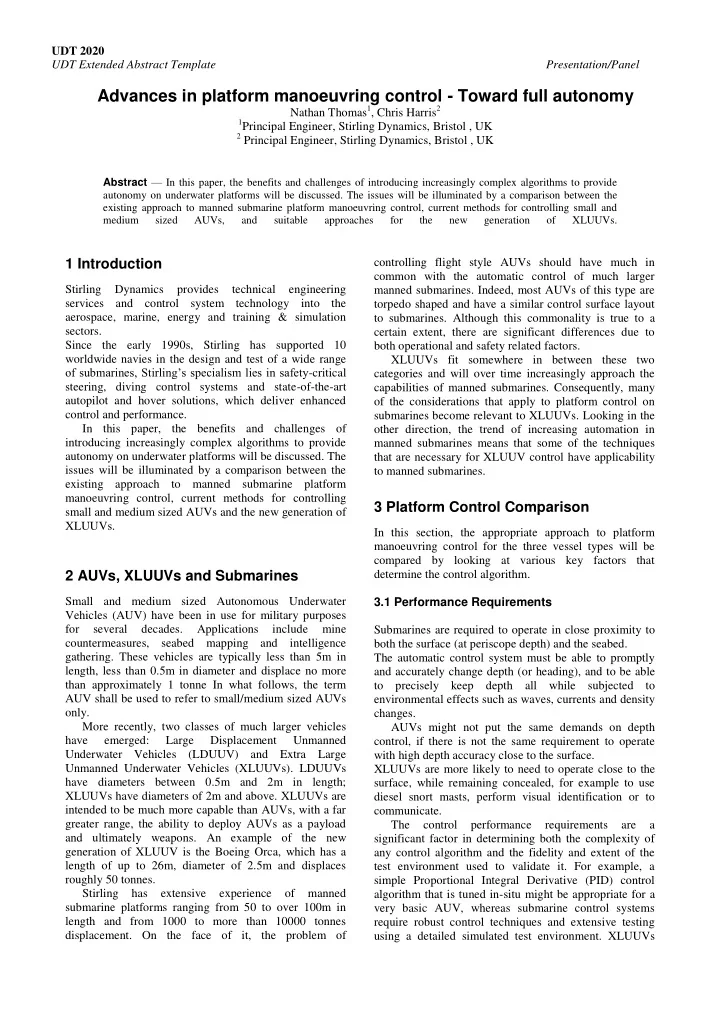

UDT 2020 UDT Extended Abstract Template Presentation/Panel Advances in platform manoeuvring control - Toward full autonomy Nathan Thomas 1 , Chris Harris 2 1 Principal Engineer, Stirling Dynamics, Bristol , UK 2 Principal Engineer, Stirling Dynamics, Bristol , UK Abstract — In this paper, the benefits and challenges of introducing increasingly complex algorithms to provide autonomy on underwater platforms will be discussed. The issues will be illuminated by a comparison between the existing approach to manned submarine platform manoeuvring control, current methods for controlling small and medium sized AUVs, and suitable approaches for the new generation of XLUUVs. 1 Introduction controlling flight style AUVs should have much in common with the automatic control of much larger Stirling Dynamics provides technical engineering manned submarines. Indeed, most AUVs of this type are services and control system technology into the torpedo shaped and have a similar control surface layout aerospace, marine, energy and training & simulation to submarines. Although this commonality is true to a sectors. certain extent, there are significant differences due to Since the early 1990s, Stirling has supported 10 both operational and safety related factors. worldwide navies in the design and test of a wide range XLUUVs fit somewhere in between these two of submarines, Stirling’s specialism lies in safety -critical categories and will over time increasingly approach the steering, diving control systems and state-of-the-art capabilities of manned submarines. Consequently, many autopilot and hover solutions, which deliver enhanced of the considerations that apply to platform control on control and performance. submarines become relevant to XLUUVs. Looking in the In this paper, the benefits and challenges of other direction, the trend of increasing automation in introducing increasingly complex algorithms to provide manned submarines means that some of the techniques autonomy on underwater platforms will be discussed. The that are necessary for XLUUV control have applicability issues will be illuminated by a comparison between the to manned submarines. existing approach to manned submarine platform manoeuvring control, current methods for controlling 3 Platform Control Comparison small and medium sized AUVs and the new generation of XLUUVs. In this section, the appropriate approach to platform manoeuvring control for the three vessel types will be compared by looking at various key factors that 2 AUVs, XLUUVs and Submarines determine the control algorithm. Small and medium sized Autonomous Underwater 3.1 Performance Requirements Vehicles (AUV) have been in use for military purposes for several decades. Applications include mine Submarines are required to operate in close proximity to countermeasures, seabed mapping and intelligence both the surface (at periscope depth) and the seabed. gathering. These vehicles are typically less than 5m in The automatic control system must be able to promptly length, less than 0.5m in diameter and displace no more and accurately change depth (or heading), and to be able than approximately 1 tonne In what follows, the term to precisely keep depth all while subjected to AUV shall be used to refer to small/medium sized AUVs environmental effects such as waves, currents and density only. changes. More recently, two classes of much larger vehicles AUVs might not put the same demands on depth have emerged: Large Displacement Unmanned control, if there is not the same requirement to operate Underwater Vehicles (LDUUV) and Extra Large with high depth accuracy close to the surface. Unmanned Underwater Vehicles (XLUUVs). LDUUVs XLUUVs are more likely to need to operate close to the have diameters between 0.5m and 2m in length; surface, while remaining concealed, for example to use XLUUVs have diameters of 2m and above. XLUUVs are diesel snort masts, perform visual identification or to intended to be much more capable than AUVs, with a far communicate. greater range, the ability to deploy AUVs as a payload The control performance requirements are a and ultimately weapons. An example of the new significant factor in determining both the complexity of generation of XLUUV is the Boeing Orca, which has a any control algorithm and the fidelity and extent of the length of up to 26m, diameter of 2.5m and displaces test environment used to validate it. For example, a roughly 50 tonnes. simple Proportional Integral Derivative (PID) control Stirling has extensive experience of manned algorithm that is tuned in-situ might be appropriate for a submarine platforms ranging from 50 to over 100m in very basic AUV, whereas submarine control systems length and from 1000 to more than 10000 tonnes require robust control techniques and extensive testing displacement. On the face of it, the problem of using a detailed simulated test environment. XLUUVs
Recommend
More recommend